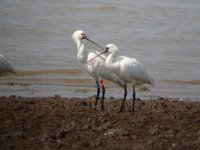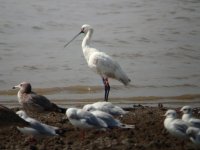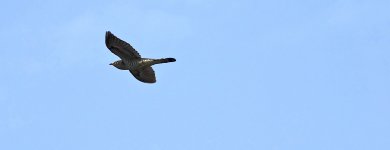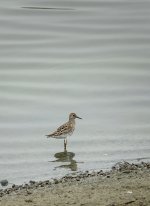-
Welcome to BirdForum, the internet's largest birding community with thousands of members from all over the world. The forums are dedicated to wild birds, birding, binoculars and equipment and all that goes with it.
Please register for an account to take part in the discussions in the forum, post your pictures in the gallery and more.
You are using an out of date browser. It may not display this or other websites correctly.
You should upgrade or use an alternative browser.
You should upgrade or use an alternative browser.
San Tin Fishponds (and beyond), Hong Kong (1 Viewer)
- Thread starter MKinHK
- Start date
More options
Who Replied?MKinHK
Mike Kilburn

Thanks Tom!
A couple more visits since early March have seen Black-faced Spoonbill numbers climb to 41, with three Eurasian Spoonbills joining the flock. Several of the Black-faced are coming into breeding plumage as they begin to think about heading back north to their nesting sites in Liaoning and the DMZ.
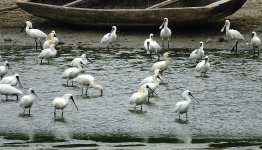
Duck numbers have stayed stable longer than I expected, with up to 80 Northern Shovelers enjoying the Flood Alleviation Pond, 56 Eurasian Teals and a female Northern Pintail and three Tufted Ducks. The big disappointment was that the Ferruginous Ducks disappeared on the day before the Bird Race - after we had checked they were still in place with what was then a dozen Tufted Ducks just the day before that! The three Eurasian Coot have also now disappeared, perhaps connected with the falling water levels on their favoured ponds.

The highlight of my visits has been the flocks of 33 and 9 Oriental Pratincoles on 18th and 21st March. One of my favourite waders, they were making good use of a mostly drained pond on which the mud had cracked, providing excellent camouflage for the roosting birds. Another wader that has been sporadic through the winter were 21 Avocets on 21st, and a true spring migrant - two Curlew Sandpipers - were among the Eurasian Teal on 21st.
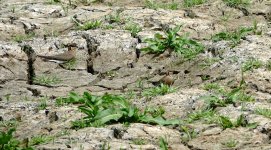
White-shouldered Starling have stared to be more visible on these visits - just as the last of the Silky Starlings have disappeared after a rather poor winter for this species. Yellow Wagtails and Richard's and Red throated Pipits are hanging on for the moment, but Zitting Cisticolas, Stejneger's Stonechats and Dusky Warblers are down to the last ones and twos - although passage birds from further south might bump these numbers temporarily. The last shot is of a Plain Prinia - a common resident which rarely merits a mention.

Cheers
Mike
A couple more visits since early March have seen Black-faced Spoonbill numbers climb to 41, with three Eurasian Spoonbills joining the flock. Several of the Black-faced are coming into breeding plumage as they begin to think about heading back north to their nesting sites in Liaoning and the DMZ.

Duck numbers have stayed stable longer than I expected, with up to 80 Northern Shovelers enjoying the Flood Alleviation Pond, 56 Eurasian Teals and a female Northern Pintail and three Tufted Ducks. The big disappointment was that the Ferruginous Ducks disappeared on the day before the Bird Race - after we had checked they were still in place with what was then a dozen Tufted Ducks just the day before that! The three Eurasian Coot have also now disappeared, perhaps connected with the falling water levels on their favoured ponds.

The highlight of my visits has been the flocks of 33 and 9 Oriental Pratincoles on 18th and 21st March. One of my favourite waders, they were making good use of a mostly drained pond on which the mud had cracked, providing excellent camouflage for the roosting birds. Another wader that has been sporadic through the winter were 21 Avocets on 21st, and a true spring migrant - two Curlew Sandpipers - were among the Eurasian Teal on 21st.

White-shouldered Starling have stared to be more visible on these visits - just as the last of the Silky Starlings have disappeared after a rather poor winter for this species. Yellow Wagtails and Richard's and Red throated Pipits are hanging on for the moment, but Zitting Cisticolas, Stejneger's Stonechats and Dusky Warblers are down to the last ones and twos - although passage birds from further south might bump these numbers temporarily. The last shot is of a Plain Prinia - a common resident which rarely merits a mention.

Cheers
Mike
Last edited:
Owen Krout
Well-known member

Great stuff, Mike. For some reason, although I am supposed to be following you I only intermittently get any email notifications. I'll just have to keep checking in on you regularly I guess.
Love the photos Mike and some great birds there. Love the pic of both spoonbill species together. There aren't too many places to get such a picture. I wish I was still in south and east Liaoning to welcome back the Black-faced Spoonbill. I think they usually arrived in late April or early May. Your Plain Prinia picture had me stumped for a while as I'm not familiar with it but knew I had seen it before somewhere in travelling. Good fun and thanks for sharing.
Tom
Tom
MKinHK
Mike Kilburn

Before moving on from the last of the winter birding I wanted to do a post on colour-ringed Black-faced Spoonbills at San Tin. One of the conservation success stories of the East Asian Australian Flyway, Black-faced Spoonbill numbers have climbed over 5,000 individuals for the first time in living memory. Hong Kong hosts a little over 6% of the wintering population and among these are birds ringed in various locations - both Hong Kong and elsewhere on the flyway. There is a register showing where each bird is ringed on the Black-faced Spoonbill Conservation Network website
Among the birds I saw in March were birds from Korea, Russia and Hong Kong. It's fun to try to figure out which bird you're looking at, especially when you don't the full combination of numbered and colour-ringed birds.
Pic 1 - The grey-ringed Russian bird at the back was ringed at a breeding colony on Furugelm Island which is the southernmost point of Far Eastern Russia, just off the border between Russia and North Korea sometime between 2006 and 20014. Unfortunately the number was not visible, so it not possible to be more precise. But it interests me for being from the northernmost known breeding colony.
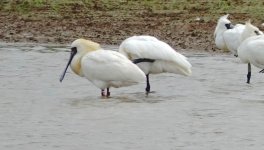
also Pic 1- The bird in breeding plumage front and left is one of five individuals ringed as chicks ( H 02, H 25, H 26, H 27, H 28) with the H numbered ring on the left leg and red over blue on the right leg. Unfortunately I could not see the lowest colour ring on the right leg. All of these birds were ringed in 2015 in Korea on one of three small islets on the west coast around the Demilitarised Zone. The website provides further interesting insights. H 02 was radio tracked for its first year, H26 was never reported subsequent to being ringed as a chick, H27, which has not been seen since 2016 (although this was in Hong Kong) and H 28 were siblings. So its most likely to be H 02, H 25 or H 28.
H02 was recorded beforehand after this date in Tai wan and is highly unlikely to have visited hong Kong in the interim
H 25 has no previous records from Hong Kong and not been seen closer than Zhejiang.
H 28 was reported at Tiaozini (part of the Yanchang wetlands) in Jiangsu on 1st April, so it would have had to travel 1300km in ten days. It has also previously been reported in Hong Kong in late March 2018, so it has some past form.
On the basis of all this info my money is on H28.
Pix 2 & 3 - A 43 with white yellow and green colour rings was ringed in Hong Kong. The earliest records are from November 2019. See link here
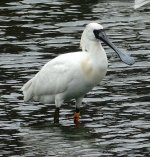
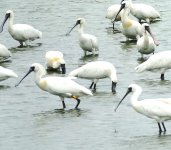
I'll post more of these here from time to time.
Cheers
Mike
Among the birds I saw in March were birds from Korea, Russia and Hong Kong. It's fun to try to figure out which bird you're looking at, especially when you don't the full combination of numbered and colour-ringed birds.
Pic 1 - The grey-ringed Russian bird at the back was ringed at a breeding colony on Furugelm Island which is the southernmost point of Far Eastern Russia, just off the border between Russia and North Korea sometime between 2006 and 20014. Unfortunately the number was not visible, so it not possible to be more precise. But it interests me for being from the northernmost known breeding colony.

also Pic 1- The bird in breeding plumage front and left is one of five individuals ringed as chicks ( H 02, H 25, H 26, H 27, H 28) with the H numbered ring on the left leg and red over blue on the right leg. Unfortunately I could not see the lowest colour ring on the right leg. All of these birds were ringed in 2015 in Korea on one of three small islets on the west coast around the Demilitarised Zone. The website provides further interesting insights. H 02 was radio tracked for its first year, H26 was never reported subsequent to being ringed as a chick, H27, which has not been seen since 2016 (although this was in Hong Kong) and H 28 were siblings. So its most likely to be H 02, H 25 or H 28.
H02 was recorded beforehand after this date in Tai wan and is highly unlikely to have visited hong Kong in the interim
H 25 has no previous records from Hong Kong and not been seen closer than Zhejiang.
H 28 was reported at Tiaozini (part of the Yanchang wetlands) in Jiangsu on 1st April, so it would have had to travel 1300km in ten days. It has also previously been reported in Hong Kong in late March 2018, so it has some past form.
On the basis of all this info my money is on H28.
Pix 2 & 3 - A 43 with white yellow and green colour rings was ringed in Hong Kong. The earliest records are from November 2019. See link here


I'll post more of these here from time to time.
Cheers
Mike
Last edited:
Owen Krout
Well-known member

Thanks, Mike, for sharing this example of how some positive progress is being made.
Owen Krout
Well-known member

Hopefully, Mike. I do know where to look. It is not surprisingly in a rather out of the way area.
Jeff Hopkins
Just another...observer

There was a large breeding colony in the Songdo part of Incheon, Korea. It was a few miles from the chemical plants in suburban Seoul that I used to support. You could get there by subway. 
Hi Mike, great to hear about the total number now over 5000, indeed a success story. I always love to hear how the DMZ is actually aiding the spoonbill recovery. Here's one photographed by Zhuanghe, Liaoning. I forget if I ever tracked down where exactly it was number banded. T69 is the number.
Attachments
MKinHK
Mike Kilburn

Hi Tom
According to the BFS Conservation Network your bird (T69) was ringed Taiwan at Tucheng in Tainan in 2015. The caption says "cured and released", so it may have been an avian botulism victim that was was taken into care and recovered its health. It also says the bird may be a hybrid, presumably with Eurasian Spoonbill.
It does look bigger than the bird in front, but that could also just be the posture.
An interesting bird!
Cheers
Mike
According to the BFS Conservation Network your bird (T69) was ringed Taiwan at Tucheng in Tainan in 2015. The caption says "cured and released", so it may have been an avian botulism victim that was was taken into care and recovered its health. It also says the bird may be a hybrid, presumably with Eurasian Spoonbill.
It does look bigger than the bird in front, but that could also just be the posture.
An interesting bird!
Cheers
Mike
Attachments
Interesting bird indeed. Very special to be able to "get to know" a specific individual. All of my other photos of this one are by itself so unfortunately there's no more size comparison opportunities. It's so special to be able to know exact individuals to form such a clear link between wintering and breeding sites. Being able to record numbered leg flags on waders along the east coast of Liaoning and reporting them to the authorities (mostly in Australia and NZ) are some of my best memories from my time in Liaoning. Godwits, Knots, Tereks, etc...
Love this stuff! Thanks for posting and sharing.
Love this stuff! Thanks for posting and sharing.

Obscene photosBefore moving on from the last of the winter birding I wanted to do a post on colour-ringed Black-faced Spoonbills at San Tin. One of the conservation success stories of the East Asian Australian Flyway, Black-faced Spoonbill numbers have climbed over 5,000 individuals for the first time in living memory. Hong Kong hosts a little over 6% of the wintering population and among these are birds ringed in various locations - both Hong Kong and elsewhere on the flyway. There is a register showing where each bird is ringed on the Black-faced Spoonbill Conservation Network website
Among the birds I saw in March were birds from Korea, Russia and Hong Kong. It's fun to try to figure out which bird you're looking at, especially when you don't the full combination of numbered and colour-ringed birds.
Pic 1 - The grey-ringed Russian bird at the back was ringed at a breeding colony on Furugelm Island which is the southernmost point of Far Eastern Russia, just off the border between Russia and North Korea sometime between 2006 and 20014. Unfortunately the number was not visible, so it not possible to be more precise. But it interests me for being from the northernmost known breeding colony.
View attachment 1380634
also Pic 1- The bird in breeding plumage front and left is one of five individuals ringed as chicks ( H 02, H 25, H 26, H 27, H 28) with the H numbered ring on the left leg and red over blue on the right leg. Unfortunately I could not see the lowest colour ring on the right leg. All of these birds were ringed in 2015 in Korea on one of three small islets on the west coast around the Demilitarised Zone. The website provides further interesting insights. H 02 was radio tracked for its first year, H26 was never reported subsequent to being ringed as a chick, H27, which has not been seen since 2016 (although this was in Hong Kong) and H 28 were siblings. So its most likely to be H 02, H 25 or H 28.
H02 was recorded beforehand after this date in Tai wan and is highly unlikely to have visited hong Kong in the interim
H 25 has no previous records from Hong Kong and not been seen closer than Zhejiang.
H 28 was reported at Tiaozini (part of the Yanchang wetlands) in Jiangsu on 1st April, so it would have had to travel 1300km in ten days. It has also previously been reported in Hong Kong in late March 2018, so it has some past form.
On the basis of all this info my money is on H28.
Pix 2 & 3 - A 43 with white yellow and green colour rings was ringed in Hong Kong. The earliest records are from November 2019. See link here
View attachment 1380635 View attachment 1380636
I'll post more of these here from time to time.
Cheers
Mike
MKinHK
Mike Kilburn

Thanks TomInteresting bird indeed. Very special to be able to "get to know" a specific individual. All of my other photos of this one are by itself so unfortunately there's no more size comparison opportunities. It's so special to be able to know exact individuals to form such a clear link between wintering and breeding sites. Being able to record numbered leg flags on waders along the east coast of Liaoning and reporting them to the authorities (mostly in Australia and NZ) are some of my best memories from my time in Liaoning. Godwits, Knots, Tereks, etc...
Love this stuff! Thanks for posting and sharing.
I have added a .pdf of the extract from the BFS Conservation Network for T69. If you go inside there is detailed info on its movements, But I couldn't see info retaliated to Laioning, so you may be able to add something useful.
Cheers
Mike
Last edited:
Thanks Mike, I wasn't sure about what you meant regarding a pdf but just finished submitting T69 under the observation report section of that website. Was able to add a photo, etc.. and I believe it went through. I'm not sure how well known the small breeding site in Liaoning is as there were only 5-7 pairs nesting when I was there almost 10 years ago now. I know that the numbers feeding at low tide on the mainland adjacent to the breeding site were slowly rising so it may be that there were other islands in the area supporting nests as well. Anyway, thanks so much for posting your photos and the website links and it was great to hear that the numbers are slowly rising for this iconic bird of East Asia!
MKinHK
Mike Kilburn

Hi TomThanks Mike, I wasn't sure about what you meant regarding a pdf but just finished submitting T69 under the observation report section of that website. Was able to add a photo, etc.. and I believe it went through. I'm not sure how well known the small breeding site in Liaoning is as there were only 5-7 pairs nesting when I was there almost 10 years ago now. I know that the numbers feeding at low tide on the mainland adjacent to the breeding site were slowly rising so it may be that there were other islands in the area supporting nests as well. Anyway, thanks so much for posting your photos and the website links and it was great to hear that the numbers are slowly rising for this iconic bird of East Asia!
I added the the pdf to post 171, so you should find it if you scroll back a little.
Cheers
Mike
MKinHK
Mike Kilburn

I'm long overdue post on the spring migration birding at San Tin covering basically all of April. The best of the action was in the good numbers of scarcer migrants on 5th April which were headlined by a wonderful flock of 22 Blue-tailed Bee-eaters that dropped onto some wires in the northeast corner of the site. A regular spring and autumn passage migrant through Hong Kong, they are never reliable, so finding a decent-sized flock is always an exciting moment, and I was delighted to get relatively close to these wonderful birds before they headed off eastward to continue their migration - with apologies for the ropey pic. I also got within striking distance of the Hong Kong record of 150 Red Turtle Doves, recording a single flock of 147 birds on the same wires that the bee-eaters dropped onto.
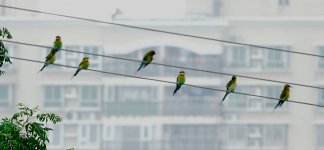

Cheers
Mike


Cheers
Mike
MKinHK
Mike Kilburn

Spring waders
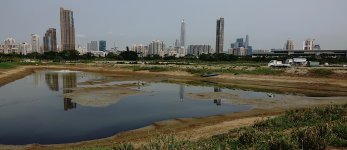

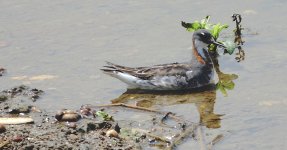


Cheers
Mike





Cheers
Mike
Last edited:
Owen Krout
Well-known member

Great to hear what is up with you, Mike. Hopefully the ability to get out and access our favorite patches will continue to improve for us all. Maybe by the fall migration things will be back to normal again.
Users who are viewing this thread
Total: 2 (members: 0, guests: 2)




